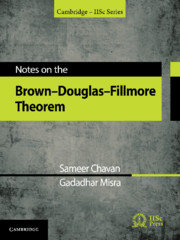Book contents
- Frontmatter
- Dedication
- Contents
- Preface
- From: The Evolution of Modern Analysis, R. G. Douglas
- Overview
- 1 Spectral Theory for Hilbert Space Operators
- 2 Ext(X) as a Semigroup with Identity
- 3 Splitting and the Mayer–Vietoris Sequence
- 4 Determination of Ext(X) as a Group for Planar Sets
- 5 Applications to Operator Theory
- Epilogue
- Appendix A Point Set Topology
- Appendix B Linear Analysis
- Appendix C The Spectral Theorem
- References
- Subject Index
- Index of Symbols
1 - Spectral Theory for Hilbert Space Operators
Published online by Cambridge University Press: 30 June 2021
- Frontmatter
- Dedication
- Contents
- Preface
- From: The Evolution of Modern Analysis, R. G. Douglas
- Overview
- 1 Spectral Theory for Hilbert Space Operators
- 2 Ext(X) as a Semigroup with Identity
- 3 Splitting and the Mayer–Vietoris Sequence
- 4 Determination of Ext(X) as a Group for Planar Sets
- 5 Applications to Operator Theory
- Epilogue
- Appendix A Point Set Topology
- Appendix B Linear Analysis
- Appendix C The Spectral Theorem
- References
- Subject Index
- Index of Symbols
Summary
The purpose of this chapter is two-fold. First, it serves as a rapid introduction to some of the basics of modern operator theory. Second, it has all the prerequisites needed to prove the Brown–Douglas–Fillmore theorem.
Unless otherwise stated, all Hilbert spaces considered in this text are assumed to be complex and separable. Whenever separability is not needed or it does not simplify the situation, the same is mentioned. Throughout this text, denotes a complex Hilbert space and stands for the algebra of bounded linear operators from into. Note that is a unital C*-algebra, where the identity operator I is the unit, composition of operators is the multiplication and the uniquely defined adjoint T* of a bounded linear operator T on Hilbert space is the involution (the reader is referred to Appendix B for the definition of a C*-algebra). To avoid ambiguity, whenever necessary, we let denote the identity operator on. Given, the symbols ker T and ran T stand for the kernel and range of the operator T, respectively. As usual, we let and denote the norm and the inner product in the Hilbert space.
Partial Isometries and Polar Decomposition
If λ is a nonzero complex number, then λ = |λ|eiθ for some real number θ; this is the polar decomposition of λ. Theorem 1.1.3 provides, for operators in L(H), a similar decomposition. The challenge is to find the two factors analogous to |λ| and eiθ in. A natural choice for |λ| quickly presents itself, namely, the operator (T*T)1/2. The choice for eiθ would seem to be either a unitary or an isometry; however, none of these choices is quite correct for an operator on a Hilbert space of dimension greater than one as we will see here.
Defnition 1.1.1
An operator is a partial isometry if for all that are orthogonal to ker. If, in addition, the kernel of V is ﹛0﹜, then V is said to be an isometry. The initial space of a partial isometry V is defined as the orthogonal complement (ker V)⊥ of ker V, whereas the final space of V is the range ran V of V.
- Type
- Chapter
- Information
- Notes on the Brown-Douglas-Fillmore Theorem , pp. 7 - 56Publisher: Cambridge University PressPrint publication year: 2021



